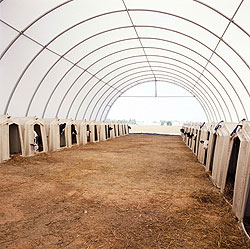Hutches
Hutches provide the best biosecurity for calves. They are isolated from one another, reducing the chances for spreading disease, and are also an affordable means to house calves.
Calves need protection from the elements and some exposure to the sun. A south–facing hutch with an open front is ideal, situated over a gravel bed 100 cm (40″) deep. Only one calf should be placed in each hutch. Bedding should be long straw four to six inches deep and changed or freshened frequently. Wood shavings covered with straw make the best bedding as the absorbency of the wood keeps the calves drier. Before moving a new group of calves into the hutches, they should be moved to different locations, cleaned and disinfected. If this is not possible, the hutches should be turned upside down and at least exposed to sunlight to rid them of any potential diseases.
The Benefits of Hutch Housing Young Dairy Calves

Warm Housing Systems
Buildings that are considered to be warm housing have mechanical ventilation and supplementary heat, and are enclosed permanent structures with an insulated exterior. There are advantages to raising calves in a warm housing system if close attention is paid to air quality, but also some draw backs.
Advantages
-
Comfort for the operator
-
Less space required per calf
-
Easier to mechanize
-
Easier to treat sick calves
-
Less possibility of water supply freezing
Disadvantages
-
Higher costs to build and operate (fuel, electricity)
-
Possible faster spread of disease due to higher concentration of animals.
-
Respiratory problems in calves if barns are not properly ventilated.
Heating
Since ventilating a barn removes heat, the small amount of heat a calf gives off may need to be supplemented. The amount of heat a calf needs depends on the number of animals in the building and the amount of wall and window space. Insulation minimizes conduction heat loss, creating an efficient heating ventilation system.
Types of Heating Systems
Gas, oil or electric heaters can all supply heat. Directional or non–directional heaters equipped with fans are not recommended, but if you do use a directional unit, do not aim it at the calf. Radiant heaters are not recommended since all objects or animals in its rays get very warm before any animals outside the rays are warmed. Each heater should be controlled by a thermostat set at one to two degrees below desired building temperatures.
Basics of Calf Housing
The Ideal Wisconsin Calf Pen Concept
